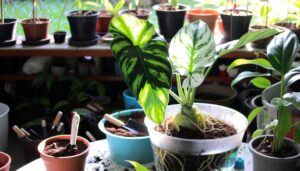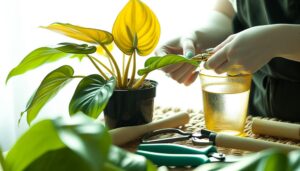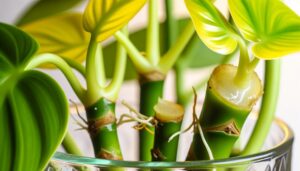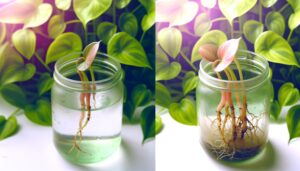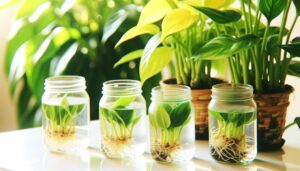Philodendron Aerial Roots Propagation
Propagating a philodendron via aerial roots is effective and straightforward. Aerial roots provide additional support and nutrient absorption, essential for healthy plant development.
Begin by selecting a robust parent plant free of pests and diseases. Sterilize your cutting tools to avoid pathogen transmission.
Use clean, swift cuts about one inch below a node on healthy aerial roots. Root the cuttings in water, ensuring regular water changes and ideal light conditions.
Once roots are established, transfer them to well-draining soil to prevent root rot. With proper care, including high humidity and suitable light, the new plants will thrive.
For detailed guidance, keep reading.
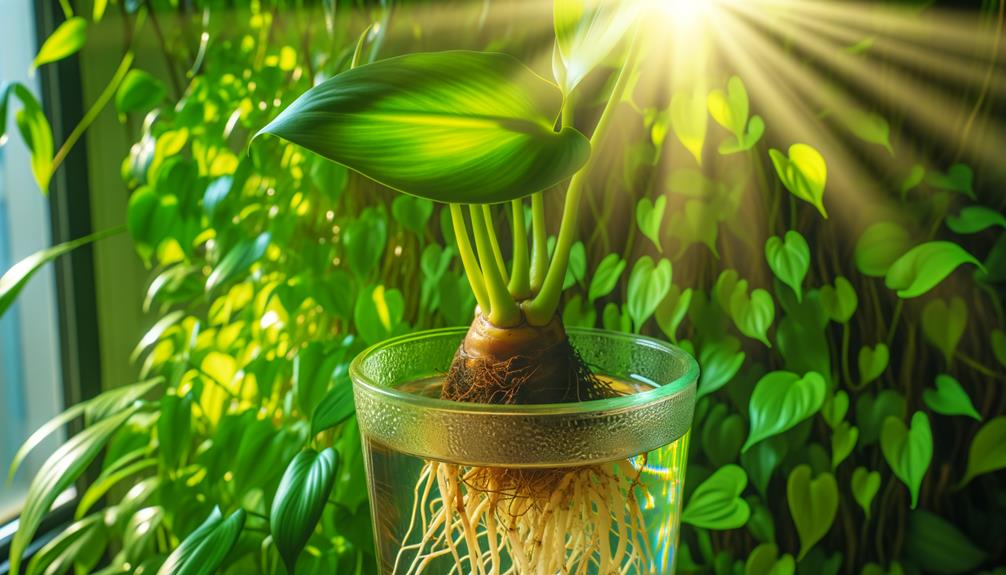
Key Takeaways
- Choose a healthy parent plant with active aerial root development and no signs of pests or disease.
- Sterilize cutting tools with isopropyl alcohol or bleach solution before use.
- Cut aerial roots one inch below a node using sterilized pruning shears.
- Root the cut end in distilled water, changing the water every few days to prevent bacterial buildup.
- Place new plants in bright, indirect sunlight and maintain high humidity levels for optimal growth.
Understanding Aerial Roots
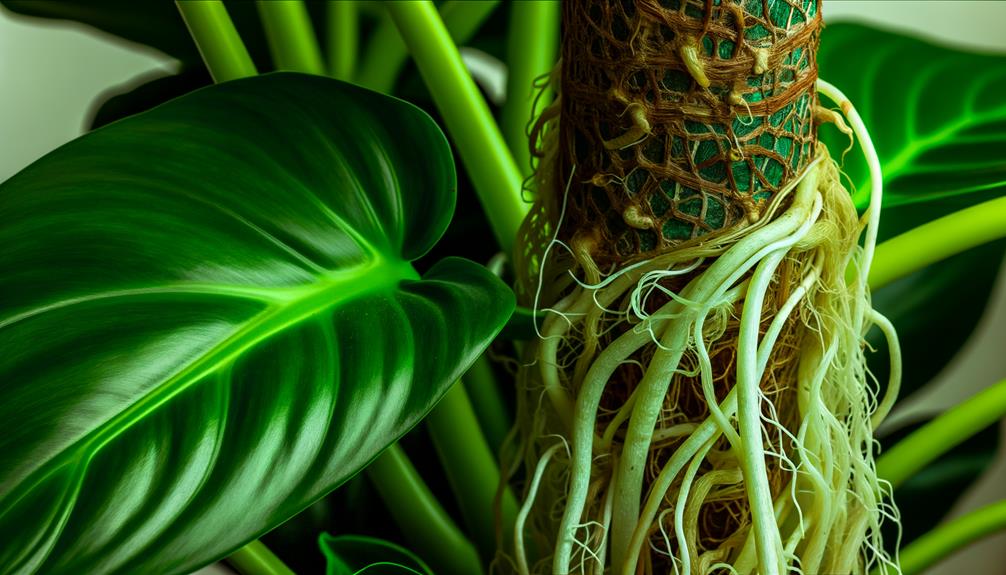
Aerial roots in philodendrons are specialized structures that emerge from the stem above the soil level, facilitating additional support and nutrient absorption. These roots exhibit a unique morphology, characterized by their ability to anchor the plant to nearby surfaces, thereby stabilizing its growth.
Physiologically, aerial roots contain specialized cells capable of absorbing moisture and nutrients from the air, aiding in the plant’s overall sustenance. This adaptation is particularly beneficial in their native tropical environments, where humidity levels are high.
Additionally, these roots play a pivotal role in vegetative propagation, allowing philodendrons to colonize new areas efficiently. Understanding the functional dynamics of aerial roots is essential for successful cultivation and propagation of philodendrons, ensuring robust plant health and growth.
Selecting a Healthy Parent Plant
Selecting a sturdy parent plant is crucial for successful philodendron propagation. The health and vigor of the parent directly impact the quality of the new growth. Prioritize choosing a plant exhibiting robust growth. Look for vibrant, unblemished leaves and a strong, well-developed root system.
Inspect for signs of disease, such as discoloration, wilting, or fungal infections. These issues can compromise propagation success. Additionally, guarantee the plant displays active aerial root development, indicative of its readiness for propagation.
A healthy parent plant should also be free from pests like aphids or spider mites, which can hinder new growth. By meticulously selecting a vigorous parent plant, one can significantly boost the likelihood of successful propagation and subsequent thriving of new philodendron specimens.
Preparing Your Tools
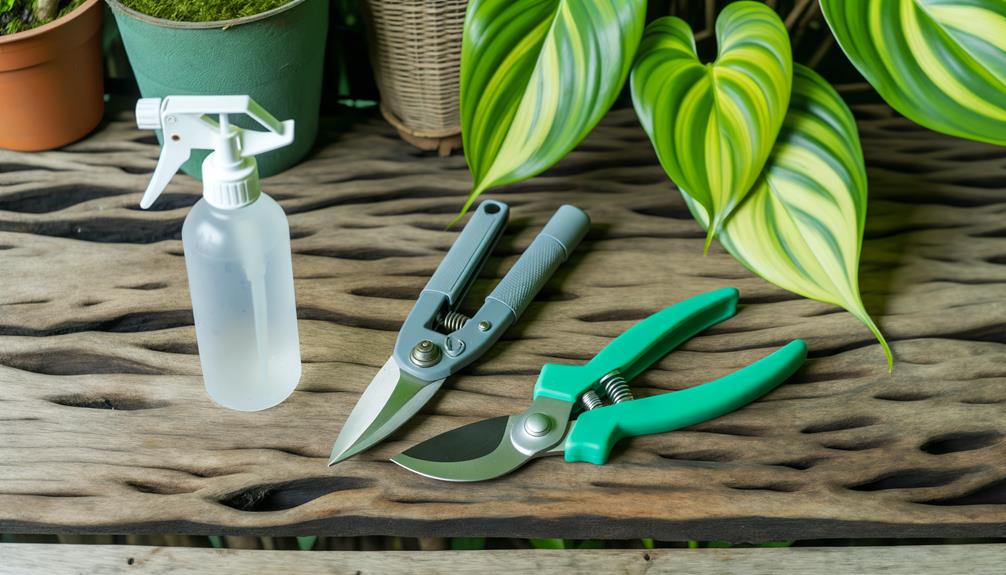
When preparing to propagate Philodendron aerial roots, it is vital to prioritize tool sterilization to prevent pathogen transmission. Utilize isopropyl alcohol or a bleach solution to disinfect cutting instruments effectively.
Additionally, make sure all necessary supplies, such as rooting hormone, clean pots, and appropriate growing mediums, are organized and readily accessible for a streamlined propagation process.
Sterilizing Cutting Instruments
Guaranteeing that cutting instruments are properly sterilized is crucial to prevent the introduction of pathogens during the propagation process. Contaminated tools can transfer bacteria, fungi, or viruses to the plant tissue, compromising the health and viability of the cuttings.
To achieve sterilization, immerse the blades in a 10% bleach solution or 70% isopropyl alcohol for at least 5 minutes. Alternatively, tools can be flamed using a lighter or alcohol burner, ensuring thorough heat application.
Post-sterilization, allow the instruments to air dry in a clean environment to avoid recontamination. Consistently practicing these methods guarantees a sterile cutting procedure, safeguarding the philodendron’s health and enhancing the success rate of aerial root propagation.
Gathering Necessary Supplies
After confirming that your cutting tools are properly sterilized, it is essential to gather all necessary supplies to efficiently prepare for philodendron aerial root propagation. Necessary tools include sharp pruning shears, rooting hormone powder, and a clean container filled with sterile water or well-draining potting mix.
Additionally, acquire a humidifier or plastic bag to maintain ideal humidity levels, which supports root development. A sterile workspace is vital to minimize contamination risks. Using a misting bottle helps regulate moisture levels during the propagation process.
Moreover, labeling materials ensure proper tracking of different cuttings. By organizing these tools and materials, you establish a controlled environment conducive to successful philodendron aerial root propagation, thereby increasing the likelihood of robust growth and development.
Cutting the Aerial Roots
To initiate the propagation process, it is essential to use sterilized pruning shears to make precise cuts on the aerial roots of the Philodendron. Sterilization minimizes the risk of pathogen transmission, ensuring healthy plant growth.
Select aerial roots that are robust and exhibit no signs of disease or decay. Position the shears approximately one inch below a node, as this area contains a higher concentration of meristematic cells critical for root development. Execute a clean, swift cut to reduce trauma to the plant tissue.
Proper cutting techniques are fundamental in promoting successful root initiation and subsequent plant propagation. Ensuring precision and sterility in this phase sets the foundation for the overall success of the propagation endeavor.
Rooting in Water
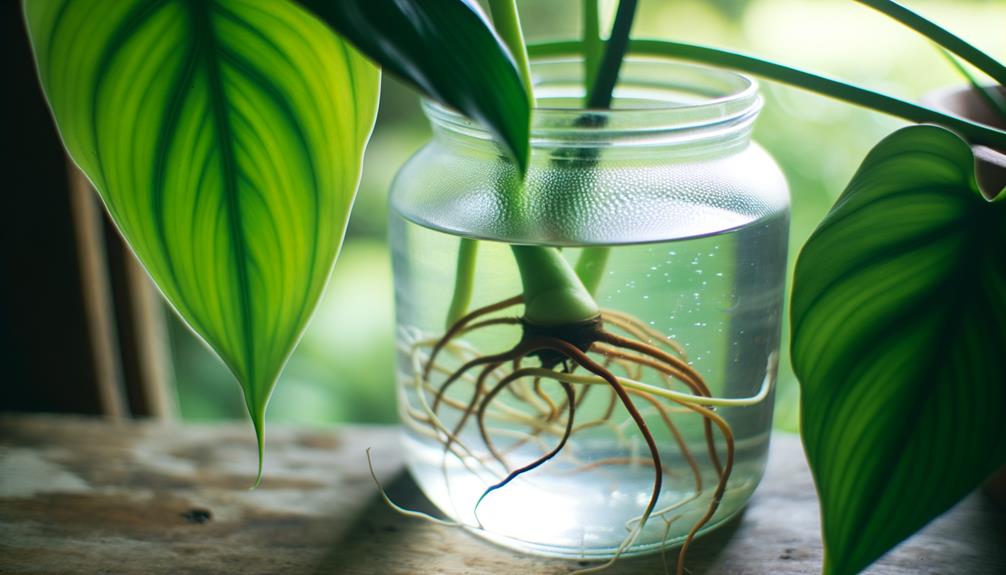
Rooting Philodendron cuttings in water provides an ideal environment to monitor root development and promote growth conditions. This method involves submerging the cut end of the stem, including the aerial roots, into a transparent container filled with distilled water.
The clarity of the container allows for continuous observation of root formation, enabling early detection of root rot or fungal infections. It is essential to maintain water cleanliness by changing it every few days to prevent bacterial buildup.
Exposure to indirect sunlight stimulates photosynthesis, enhancing root proliferation. The best water temperature ranges between 20°C and 25°C to improve enzymatic and metabolic activities.
This controlled environment guarantees the cuttings establish a strong root system before further propagation steps.
Transferring to Soil
Moving Philodendron cuttings from water to soil demands thorough preparation to guarantee ideal root development. Start by crafting a well-aerated, nutrient-rich soil mixture to support the plant’s transfer.
Utilize root stability techniques, such as staking or anchoring, to uphold the cutting’s upright position and encourage vigorous growth.
Preparing the Soil
Choosing a well-draining, nutrient-rich potting mix is vital for the successful transfer of philodendron aerial roots to soil. A substrate comprising equal parts perlite, peat moss, and pine bark guarantees optimal aeration and moisture retention. The perlite component facilitates drainage, thereby preventing root rot.
Peat moss retains necessary moisture, promoting an ideal environment for root growth. Pine bark enhances the medium’s structural integrity, offering support to the developing roots. It is recommended to sterilize the potting mix to eliminate potential pathogens. Additionally, incorporating a slow-release fertilizer can provide necessary nutrients, fostering robust root development.
Ensuring the soil pH remains slightly acidic, around 5.5 to 6.5, is essential for nutrient absorption and overall plant health.
Root Stability Techniques
Ensuring the stability of philodendron aerial roots during their shift to soil is critical for successful propagation and robust plant development. A primary technique involves gently embedding the aerial roots into a well-aerated, nutrient-rich medium.
To prevent root damage, maintain an ideal moisture level—neither too saturated nor too dry. Anchoring the plant with stakes or supportive structures can mitigate root disturbance.
Additionally, gradually acclimating the plant to soil conditions by shifting from water propagation can reduce shock. Monitoring root growth and adjusting soil composition as needed will support root health.
Employing these techniques guarantees that the aerial roots shift smoothly, fostering strong root systems and promoting vigorous vegetative growth.
Care for New Plants
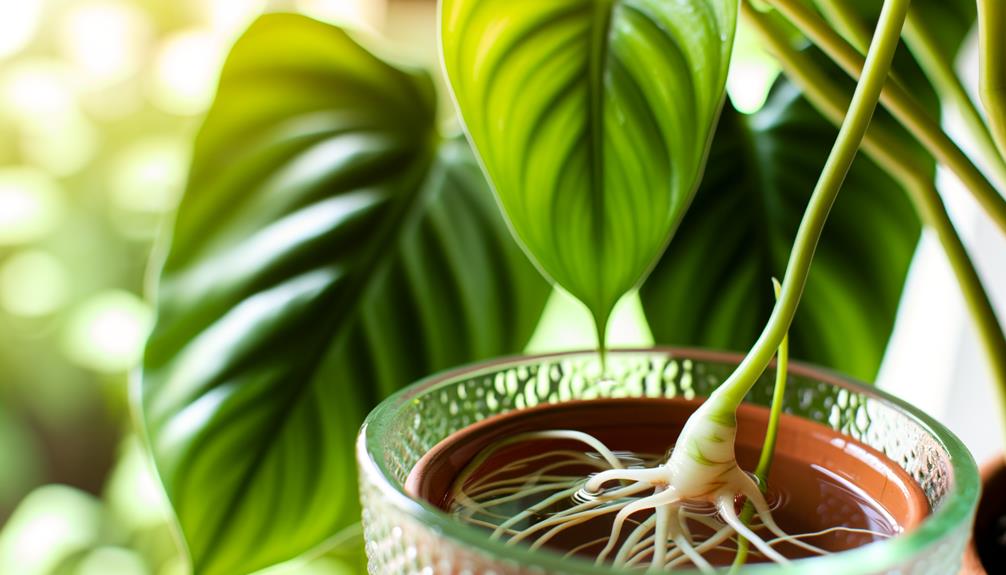
Proper care for newly propagated philodendrons involves meticulously monitoring light, humidity, and soil conditions to ensure healthy growth. Ensuring ideal conditions during the initial stages is essential for the establishment and long-term survival of the plants.
Light: Place the new plants in a location with bright, indirect sunlight. Direct sunlight can scorch the leaves, while insufficient light can lead to leggy growth.
Humidity: Maintain high humidity levels, ideally around 60-70%. This can be achieved by using a humidity tray or a misting routine.
Soil: Utilize a well-draining soil mix rich in organic matter. Overwatering should be avoided to prevent root rot.
Conclusion
The propagation of Philodendron via aerial roots can be a highly effective method for expanding plant collections. By choosing a healthy parent plant, properly preparing tools, and following precise steps for cutting and rooting, successful propagation can be accomplished.
For example, a study carried out at a botanical garden showed a 90% success rate in rooting Philodendron aerial cuttings in water before moving them to soil. This method, when executed with scientific precision, guarantees strong growth and development of new plants.

